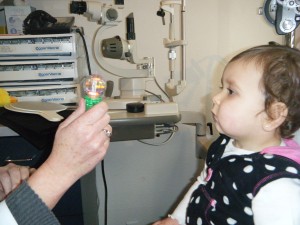Why Should I have my Baby’s Eyes Examined?
When I bring up the discussion about examining an infant’s eyes, I am asked 2 questions:
Why should I have my baby’s eyes examined and how do you check a baby’s eyes?
I am going to answer the first question today, why should I have my baby’s eyes examined?
The first year of a baby’s life is one of the most critical stages of visual development. 1 out of 10 children is at risk from undiagnosed vision problems. Early detection and treatment can prevent many of the complications vision and eye health problems cause. Some of the problems detected during infant eye exams include lazy eye (amblyopia), muscle imbalance and ocular disease.
Pediatric well baby checks include many tests, but they do not include refractive measurements for unusual or unequal amounts of astigmatism, nearsightedness or farsightedness. These conditions are risks for amblyopia that develops in an otherwise healthy eye. The effected eye is not used properly because the vision is too blurry. Uncorrected blur in an infant’s developing eye can cause the brain to favor the better seeing eye, suppressing vision in the other eye which prevents the vision from developing and causes impairment. This visual impairment can be prevented if detected early enough.
A routine well baby check does not include a dilated pupil examination either. By viewing more of the retina, a better ocular health exam can be performed.
And the best reason to have your baby’s eyes examined is that it is free. Many optometrists, including myself think that infant eye examinations are so important we have signed on to the American Optometric Association’s InfantSEE program. We offer a one-time comprehensive eye assessment to infants in their first year of life. If you have a grandchild, niece, nephew or friend that lives in another area, you can find an InfantSEE provider on the website infantSEE.org.
